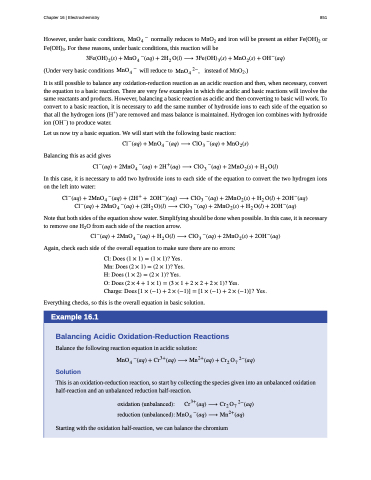Page 861 - Chemistry--atom first
P. 861
Chapter 16 | Electrochemistry 851
However, under basic conditions, ���� � normally reduces to MnO2 and iron will be present as either Fe(OH)2 or Fe(OH)3. For these reasons, under basic conditions, this reaction will be
����������� � ���� ����� � ��� ���� � ����������� � ������� � �������
(Under very basic conditions ���� � will reduce to ���� ��� instead of MnO2.)
It is still possible to balance any oxidation-reduction reaction as an acidic reaction and then, when necessary, convert the equation to a basic reaction. There are very few examples in which the acidic and basic reactions will involve the same reactants and products. However, balancing a basic reaction as acidic and then converting to basic will work. To convert to a basic reaction, it is necessary to add the same number of hydroxide ions to each side of the equation so that all the hydrogen ions (H+) are removed and mass balance is maintained. Hydrogen ion combines with hydroxide ion (OH−) to produce water.
Let us now try a basic equation. We will start with the following basic reaction:
������� � ���� ����� � ���� ����� � �������
������� � ����� ����� � ������� � ���� ����� � �������� � �� ����
In this case, it is necessary to add two hydroxide ions to each side of the equation to convert the two hydrogen ions on the left into water:
������� � ����� ����� � ���� � ��������� � ���� ����� � �������� � �� ���� � �������� ������� � ����� ����� � ���� ����� � ���� ����� � �������� � �� ���� � ��������
Note that both sides of the equation show water. Simplifying should be done when possible. In this case, it is necessary to remove one H2O from each side of the reaction arrow.
������� � ����� ����� � �� ���� � ���� ����� � �������� � �������� Again, check each side of the overall equation to make sure there are no errors:
��� ���� �� � �� � �� � ��� ����
��� ���� �� � �� � �� � ��� ����
�� ���� �� � �� � �� � ��� ����
�� ���� �� � � � � � �� � �� � � � � � � � � � ��� ����
������� ���� �� � ���� � � � ����� � �� � ���� � � � ������ ����
Everything checks, so this is the overall equation in basic solution.
Balancing this as acid gives
Example 16.1
Balancing Acidic Oxidation-Reduction Reactions
Balance the following reaction equation in acidic solution:
���� ����� � �������� � �������� � ��� �� ������
This is an oxidation-reduction reaction, so start by collecting the species given into an unbalanced oxidation
half-reaction and an unbalanced reduction half-reaction.
��������� ������������� �������� � ��� �� ������ ��������� ������������� ���� ����� � ��������
Starting with the oxidation half-reaction, we can balance the chromium
Solution


